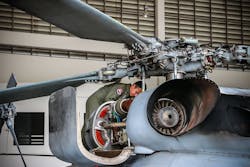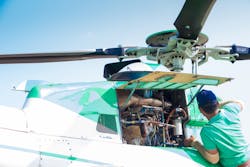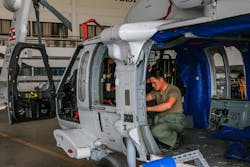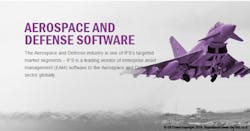Four disruptive developments that will impact rotorcraft maintenance in defense
Helicopters are vital tactical assets during military operations, but also some of the most complex. The shift from conventional to asymmetric warfare has required operations in challenging environments, meaning increased pressure for maintenance, repair, and overhaul (MRO) departments. Advancements in technology have made rotor-wing fleets more complex, making the task of capability management even harder for defense forces. Kevin Deal, vice president of Aerospace and Defense at IFS North America, looks at the key developments that will impact asset management and takes a look at sixth-generation logistical support.
Military doctrine and warfare have changed significantly over the past 20 years. Equipment is seldom being pre-positioned forward at main operating bases, and defense forces are now providing engineering across first, second, and third line support, with industry becoming involved mostly in the fourth line, where they provide maintenance, repair, and overhaul (MRO) capabilities. The change of emphasis from a static force to the need for capability projection and expeditionary warfare now requires rapid deployment and flexibility, demanding a new operational model for equipment acquisition, management and ownership.
The capability management challenge
Organizations are focused on capabilities that balance through-life costs and operational effectiveness. This means leveraging the cost savings and process improvements enabled by a whole new set of disciplines and business processes with new business models, such as Contractor Logistics Support, Performance Based Logistics, and Product Support Agreement programs. The result is that regardless of whether the support environment is undertaken by uniformed personnel, by a third party, or an OEM, suppliers have to deal with the increasing complexity of product, contract, and supplier relationships.
Information systems used must be functional enough to gather the data required to monitor key performance indicators and review activity but also deliver visual insight to understand enterprise performance and enable better decision-making.
Jaochainoi / Shutterstock.com
Where will we go from here?
From an operational perspective, there are four key developments, which I predict will have a significant impact on long-term strategies in helicopter maintenance support:
1. Self-Analysis and Reporting – Health and Usage Monitoring Systems (HUMS) is a capability that has been used consistently for a number of years, but the change we are likely to see in the future is how it integrates into the enterprise solution. Equipment will report its current configuration in real time, and usage information will be analyzed and on-ground maintenance instantly scheduled – integrated enterprise solutions can start delivering operational and business case benefits.
2. Mobile – Tailoring mobile apps to meet the specific needs of solution users is where mobile has the potential to do something significant. Mobile apps offer a solution of gaining essential feedback of specific operational information without inundating the user with functionality, in a format optimized for specific equipment, easily customizable, and devoid of superfluous overhead.
3. Context Aware – Solutions will automatically tailor their operation through recognition of the maintenance environment they are in. Being aware of unique environments in the field will enable tailoring in more effective ways, making life easier for the user.
4. Augmented Reality – Sophisticated technology will move into the practical utilization space. Augmented reality solutions are able to provide expertise and instruction on demand. For example, using a live feed from an engineer's headset, an expert can guide and instruct maintenance that may well be taking place in a difficult to reach location. We will see solutions move to being interfaced with the enterprise solution, with feeds of maintenance information being two-way in real time.
Jaochainoi / Shutterstock.com
The future – Sixth Generation Logistical Support Enterprise (GLSE)
Over the next 20 years, we will see the full integration of operations, maintenance and the supply chain into a ‘logistics support enterprise’ alongside the continuation of the current move toward more modular applications-based ERP software. This new agile breed of solutions is removing the time and pain required to adapt processes using the more traditional, monolithic ERP systems.
This future generation of logistics solutions will see support optimization through probabilistic methodology with the capability to dynamically interact with the in-service support solutions. Also embedded within it is workforce scheduling and planning capabilities built to respond in real time to real-world events.
Technology will increasingly be used to create an environment to better enable the user to do their job, reducing solution overhead, while also providing the always-essential feedback loop. Advanced equipment must be matched by an advanced model for asset acquisition, management and ownership. Defense forces must embrace these new technological developments – or face being caught flat-footed when helicopter availability is mission-critical.
About the author: Kevin Deal, Vice President for Aerospace and Defense for IFS North America
Kevin is responsible for all aspects of IFS in Aerospace and Defense within North America, and has been in the A&D IT business for over 25 years. Prior to joining IFS, Kevin held a number of roles as Director of Mid-Americas and Federal at BroadVision, as well as Director of National Sales at Cincom. Kevin was also a logistics war modeler and former Director of the DoD’s Supportability Investment Decision Analysis Center (SIDAC).IFS™ develops and delivers enterprise software for enterprise resource planning (ERP), enterprise asset management (EAM), and enterprise service management (ESM). IFS brings customers in targeted sectors closer to their business, helps them be more agile, and enables them to profit from change. IFS is a public company (XSTO:IFS) founded in 1983 and currently has over 2,800 employees. IFS supports more than 1 million users worldwide from its network of local offices and through a growing ecosystem of partners.
IFS Applications also supports:
- the management of complex value chains for inventory;
- all three kinds of maintenance repair and overhaul (MRO): heavy, complex, and component, in addition to line maintenance or at platform/asset support; and
- performance-based logistics solutions (PBL) or power by the hour solutions for the military, service providers, vendors, government and military organizations and civil aviation MRO shops.
You might also like:
Subscribe today to receive all the latest aerospace technology and engineering news, delivered directly to your e-mail inbox twice a week (Tuesdays and Thursdays). Sign upfor your free subscription to the Intelligent Inbox e-newsletter at http://www.intelligent-aerospace.com/subscribe.html.
Connect with Intelligent Aerospace on social media: Twitter (@IntelligentAero), LinkedIn,Google+, and Instagram.
Intelligent Aerospace
Global Aerospace Technology NetworkIntelligent Aerospace, the global aerospace technology network, reports on the latest tools, technologies, and trends of vital importance to aerospace professionals involved in air traffic control, airport operations, satellites and space, and commercial and military avionics on fixed-wing, rotor-wing, and unmanned aircraft throughout the world.






